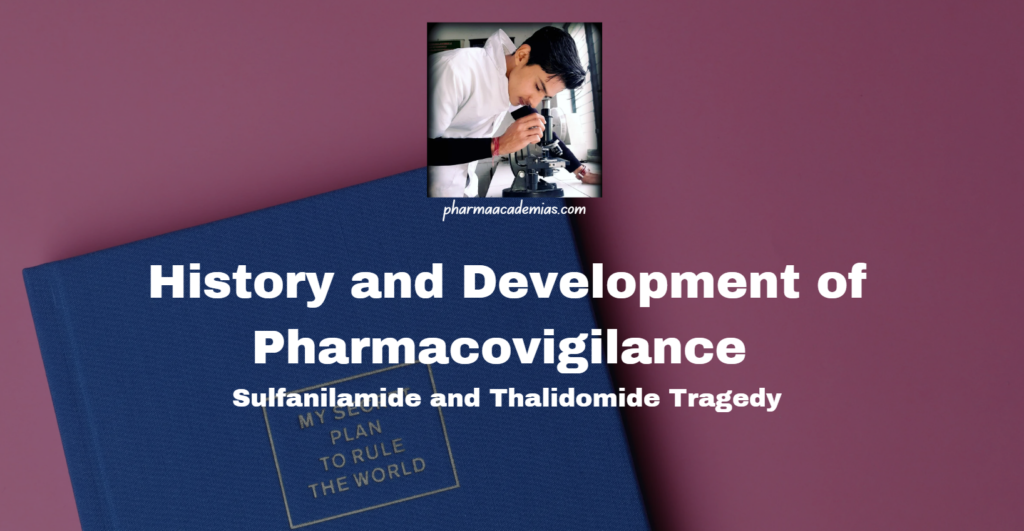Early Beginnings: The practice of pharmacovigilance can be traced back to the early 20th century, though its formal development began much later. Drug safety issues have been a concern since the introduction of modern pharmaceuticals, but the actual systematic reporting and monitoring mechanisms were non-existent until mid-20th century.
The Sulfanilamide Tragedy (1937): A Turning Point in Drug Regulation
The Sulfanilamide Tragedy of 1937 is one of the deadliest pharmaceutical disasters in U.S. history, leading to the deaths of over 100 people, including many children. This incident directly resulted in the enactment of the Federal Food, Drug, and Cosmetic Act (FD&C Act) of 1938, which significantly strengthened drug regulations in the United States.

Background: The Discovery of Sulfanilamide
Sulfanilamide, a sulfa drug, was one of the first antibiotics available for treating bacterial infections. It was widely used to treat streptococcal infections and had proven to be effective in pill or powder form. However, some patients, particularly children, found it difficult to swallow tablets or powders, leading to demand for a liquid formulation.

The Fatal Mistake: Elixir Sulfanilamide
In 1937, S.E. Massengill Company, a pharmaceutical firm based in Tennessee, formulated a liquid version of sulfanilamide and marketed it as Elixir Sulfanilamide. The company’s chief chemist and pharmacist, Harold Watkins, used diethylene glycol (DEG) as a solvent to dissolve the sulfanilamide, making the drug easier to consume.
Why Was This Dangerous?
- Diethylene glycol (DEG) is a highly toxic industrial chemical used in antifreeze and brake fluid.
- At the time, drug safety testing was not required by law, and the company did not conduct toxicological studies before distributing the drug.
- The sweet taste of DEG masked its toxicity, making it even more dangerous.
The Elixir Sulfanilamide was distributed across the United States in September 1937.
The Deadly Consequences
Soon after patients began taking Elixir Sulfanilamide, reports of severe illness and deaths emerged.
Symptoms of Diethylene Glycol Poisoning
Victims suffered from:
- Severe abdominal pain
- Vomiting and diarrhea
- Kidney failure (the most common cause of death)
- Convulsions and coma
Within weeks, over 100 people, including many children, had died.
The Government Response
The U.S. Food and Drug Administration (FDA), under the leadership of Dr. Walter Campbell, launched an emergency investigation.
Steps Taken by the FDA
1. Tracing the Drug: The FDA worked tirelessly to track down all shipments of the elixir.
2. Public Warnings: Urgent warnings were issued to doctors, pharmacists, and the public.
3. Seizing the Drug: The FDA confiscated as much of the deadly elixir as possible.
4. Interviews and Reports: Survivors and family members of victims were interviewed to gather evidence.
The Massengill Company was not prosecuted for causing deaths because no law required drug companies to prove safety before selling drugs. However, the company was fined under a technical violation—mislabeling the drug as an “elixir” without containing alcohol.
Harold Watkins, the chemist responsible for formulating the drug, later committed suicide due to guilt over the disaster.

Impact on Drug Regulation: The Birth of the FD&C Act (1938)
The public outrage following the tragedy led directly to the passage of the Federal Food, Drug, and Cosmetic Act (FD&C Act) of 1938.
Key Changes Introduced by the FD&C Act
1. Mandatory Safety Testing: Drug manufacturers were now required to prove a drug’s safety before marketing it.
2. FDA Approval Requirement: The FDA had the authority to approve or reject new drugs.
3. Stronger Labeling Laws: Proper labeling of drugs became mandatory, preventing misleading claims.
4. Factory Inspections: The FDA gained the power to inspect drug manufacturing facilities.
5. Regulation of Toxic Ingredients: Dangerous substances like diethylene glycol were strictly controlled.
Legacy of the Sulfanilamide Tragedy
- This event transformed the pharmaceutical industry and drug regulation.
- It led to stronger consumer protections in the U.S. and later influenced drug safety laws worldwide.
- The tragedy is often cited as an example of why rigorous drug testing is essential before any pharmaceutical product reaches the market.


